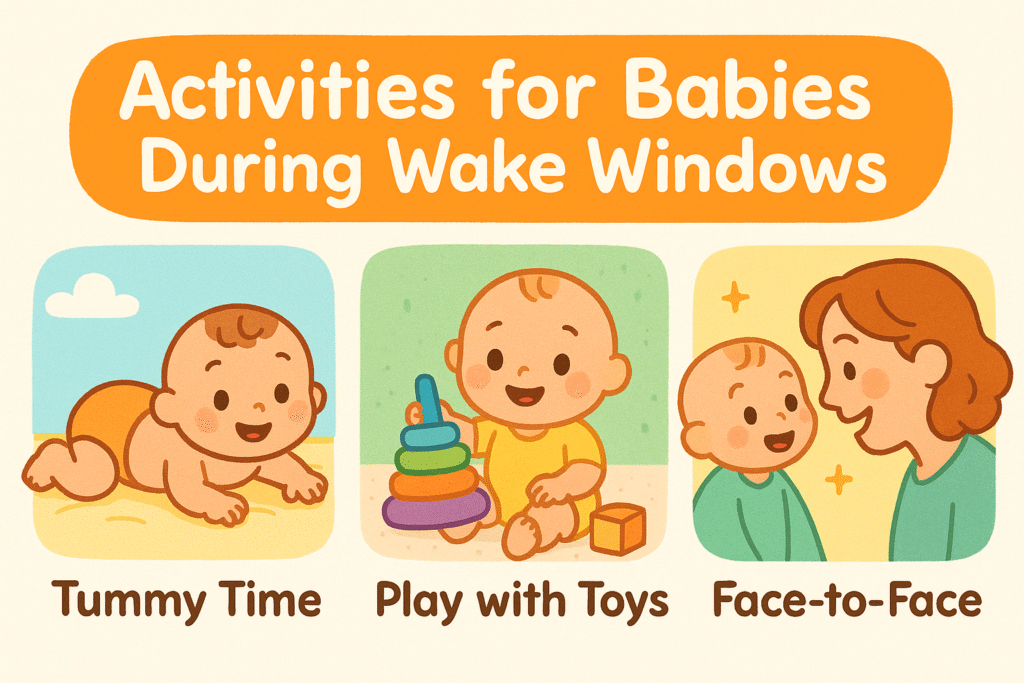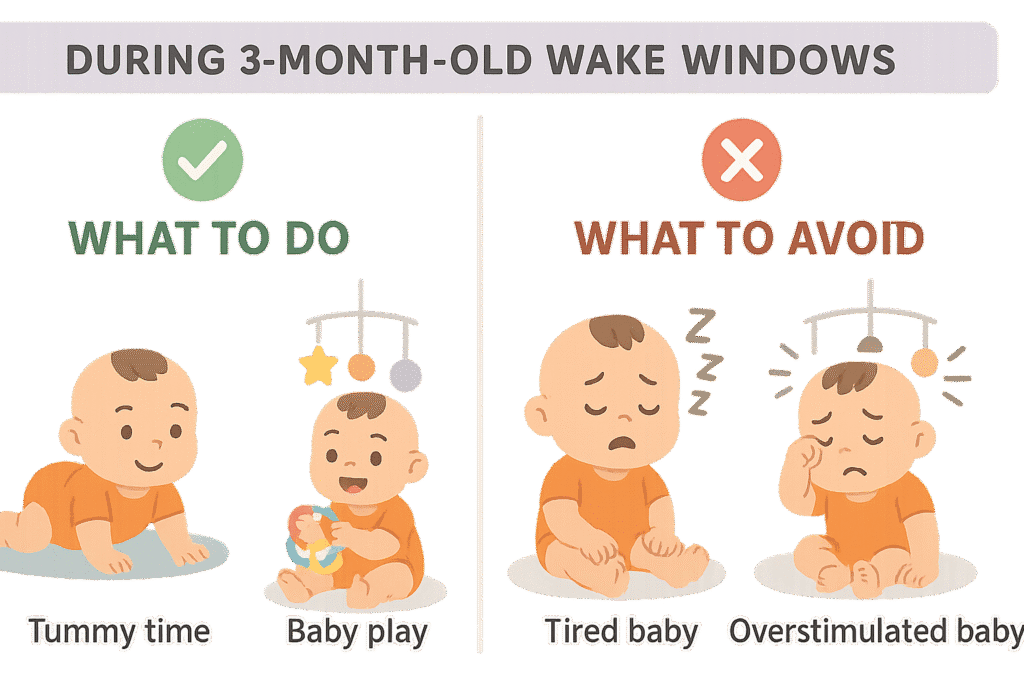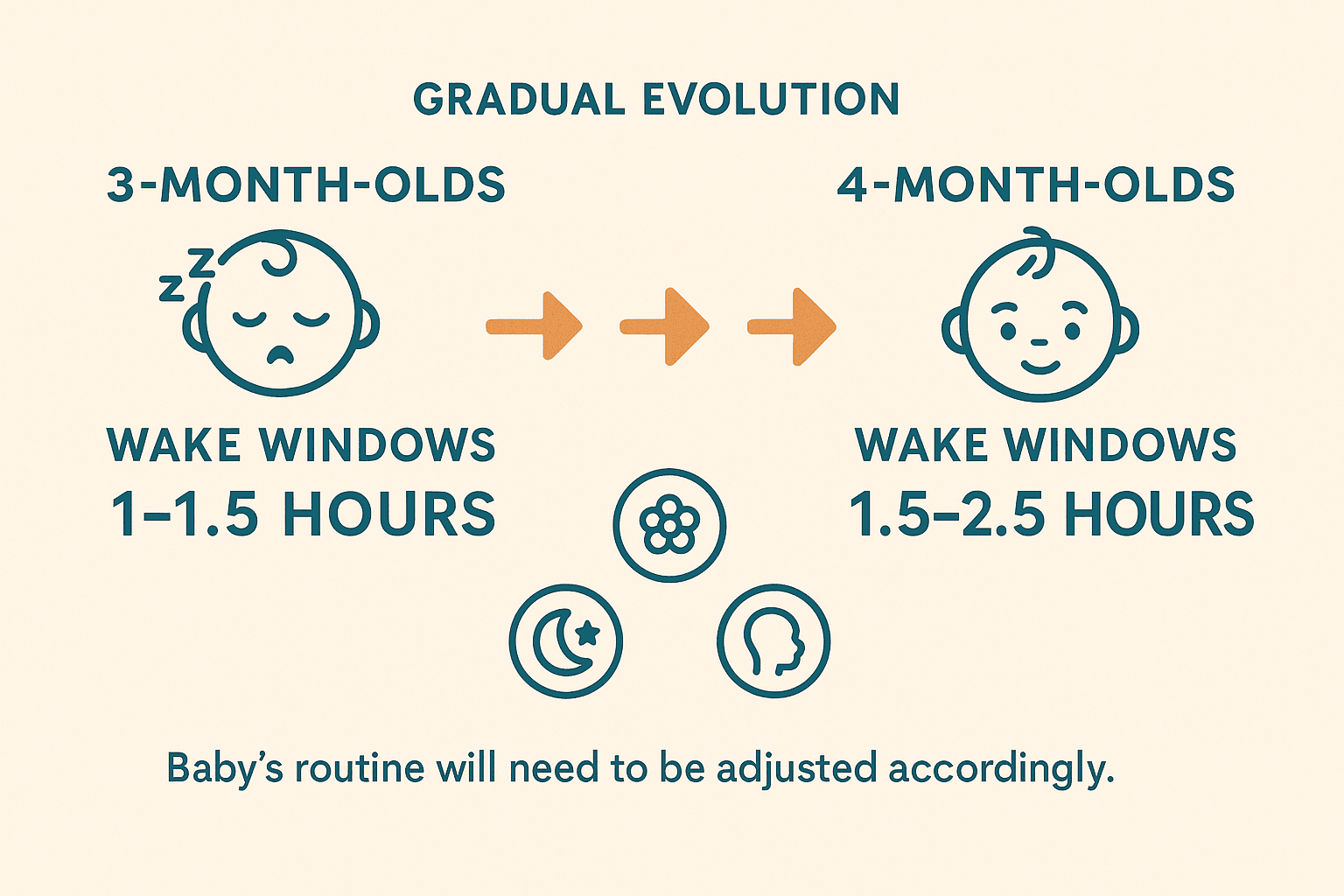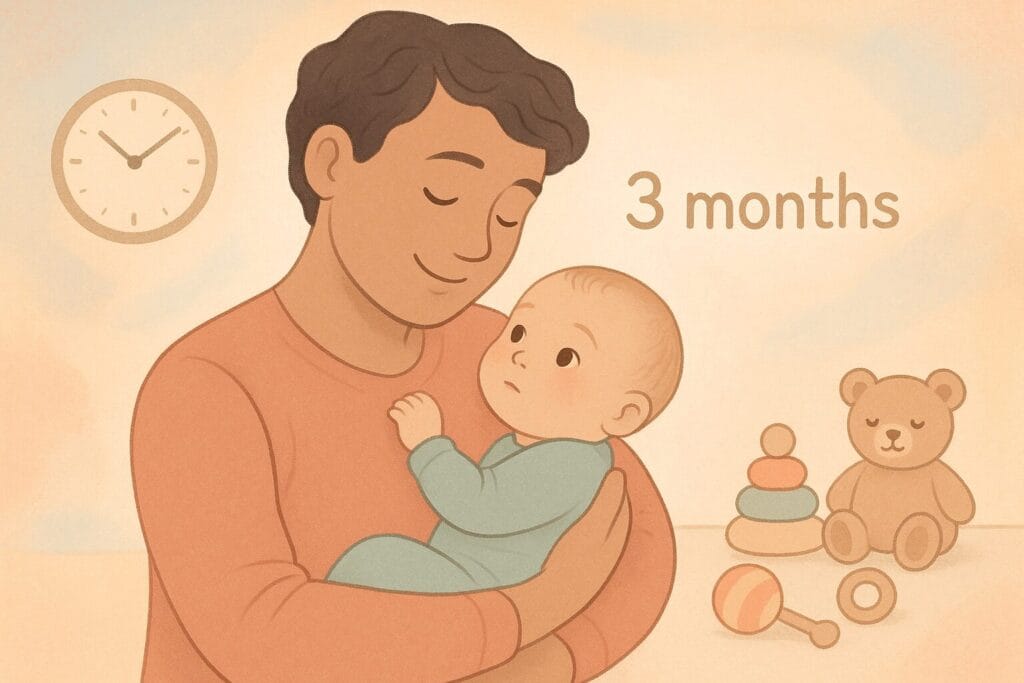Master the art of managing wake windows for your 3-month-old baby with comprehensive strategies and insights. At this age, ideal wake windows typically range from 75 to 120 minutes, depending on your baby’s needs and temperament. Understanding these timeframes is crucial for helping your baby make the most of their sleep cycles.
In addition to outlining the optimal lengths of wake windows, we offer practical tips to create a calming environment that promotes relaxation and recharges your baby’s energy. Discover techniques such as engaging in gentle play, recognising your baby’s sleepy cues, and establishing consistent routines that can help facilitate deeper sleep and foster healthy development. Equip yourself with the knowledge you need to ensure your little one rests well and thrives!
Table of Contents
The Importance of 3-Month-Old Wake Windows for Your Baby’s Sleep Routine
As a new parent, understanding your 3-month-old’s wake windows can feel like trying to solve a puzzle. It’s common to wonder, “How long should my 3-month-old be awake before their next nap?” or “How do I know if my baby is overstimulated?” In this post, we’ll answer these questions and guide you through the importance of wake windows for your little one.
Why Are 3-Month-Old Wake Windows Important?
Your baby’s 3-month-old wake windows ensure they don’t become overtired or under-stimulated. This period of wakefulness directly impacts your baby’s sleep patterns and overall mood. By managing the right amount of awake time between naps, you’ll help your baby establish healthier sleep habits. This is especially important at three months when their sleep cycle begins to mature, and they need a balance of sleep and playtime.
How to Manage 3-Month-Old Wake Windows
Typically, a 3-month-old’s wake window lasts 1 to 2 hours. During this time, your baby is awake and alert, taking in its surroundings. However, every baby is different; some may need a shorter or longer window. Understanding your baby’s cues is key. Look for signs of tiredness, like rubbing their eyes or yawning, to know when to put them down for a nap.
The Benefits of Properly Timed Wake Windows
By getting the timing of 3-month-old wake windows right, you’ll set up your baby for more restful naps and better nighttime sleep. Managing these wake windows reduces the risk of your baby becoming overtired, which can lead to difficulty falling asleep or staying asleep. With a balanced routine, you and your baby can enjoy calmer days and better sleep.
What is a Wake Window for a 3-Month-Old?
Wake windows refer to when a 3-month-old stays awake between naps. This time is essential for a baby’s physical and cognitive development. By understanding and managing wake windows, you can ensure your baby is neither overtired nor understimulated.
Typical Wake Windows for 3-Month-Olds
The typical wake window for a 3-month-old lasts between 1 and 2 hours. During this time, babies are alert and engaged, but not exhausted. Recognising this window will help you schedule naps, promoting better sleep and mood.
3-Month-Old Wake Windows Length

The length of the 3-month-old wake window can vary. Some babies may only need an hour of wake time, while others can stay awake for longer. The key is to find the right balance for your baby, adjusting based on signs of tiredness or engagement.
Why Wake Windows Matter for 3-Month-Olds
Managing your 3-month-old’s wake windows is crucial for your baby’s well-being. Proper wake time supports growth and prevents the frustration of missed sleep. It helps establish a predictable routine you and your baby can rely on.
For helpful tips and expert advice on getting your baby to sleep comfortably in a bassinet, read our comprehensive guide on How to Get Baby to Sleep in Bassinet: A Complete Guide for Parents.”
How Long Should Wake Windows Be for 3-Month-Olds?
You’re not alone if you ask, “How long should wake windows be for 3-month-olds?”. Many parents struggle with finding the right balance between nap times and awake periods. Understanding your baby’s 3-month-old wake windows is key to promoting healthy sleep and development. This article will help you navigate these essential windows for optimal rest and engagement.
The Importance of Wake Window Duration
The duration of 3-month-old wake windows is crucial for your baby’s development. Typically, 3-month-old wake windows range from 1 to 2 hours. Ensuring your baby stays awake during this optimal window helps them engage with their environment without becoming overtired. Proper wake window management will lead to better sleep patterns and mood for your baby.
How Long is a 3-Month-Old’s Wake Window?
The length of a 3-month-old’s wake windows can vary depending on the time of day. In the morning, your baby might be able to handle a longer wake window, while in the evening, they may need a shorter one. Knowing the typical 3-month-old wake windows duration helps you adjust to your baby’s needs throughout the day.
Wake Window Variability
Every baby has different needs regarding 3-month-old wake windows. While some babies thrive with a shorter, 1-hour wake window, others may handle a longer stretch. The key is to watch for signs of tiredness and adjust the 3-month-old wake windows accordingly, whether it’s a quick nap or a longer awake period.
Wake Window Activities for a 3-Month-Old

Knowing how long your baby should be awake is important, but making the most of their 3-month-old wake windows is equally essential. Proper activities during their wake time will support their growth and keep them engaged. This section will guide you through the best wake window activities for 3-month-olds.
What to Do with Your 3-Month-Old During Wake Windows
During your baby’s 3-month-old wake windows, engage in simple activities to stimulate their development. These could include tummy time, gentle talking or singing, or showing them colorful objects. These activities help with motor skills, cognitive development, and emotional bonding, and they are essential for their growth.
3-Month-Old Wake Windows Ideas
Looking for more enriching wake-and-play ideas for 3-month-olds? You can introduce soft toys for your baby to grab, provide rattles for sound stimulation, or engage in face-to-face interaction. These simple, sensory activities help your baby learn about the world around them, making the most of their awake time.
What to Avoid During Wake Windows

While making the most of your 3-month-old wake windows is essential, avoiding overstimulating or under-stimulating your baby is equally crucial. Too much activity can overwhelm your little one, while too little can lead to boredom. Be mindful of the balance, ensuring that what to do during the 3-month-old wake windows aligns with their mood and energy levels.
How to Identify When to Put Your 3-Month-Old Back to Sleep

Knowing when your 3-month-old is ready for another nap can be just as challenging as figuring out wake windows for 3-month-olds. Understanding when your baby needs rest to avoid overtiredness is crucial. By recognizing the right signs and timing naps correctly, you can establish a more predictable sleep routine for your baby.
Signs of an Overtired Baby
If your baby has stayed awake too long, there are clear signs that indicate they need rest. A 3-month-old who is overtired may start rubbing their eyes, yawning, or become more fussy. Understanding these signs will help you avoid missing the right wake windows for 3-month-olds and prevent your baby from becoming overtired. Properly managing 3-month-old naps and wake windows ensures your baby stays content and rested.
Recognising the Right Time for Naps
Timing naps effectively is just as crucial as managing wake windows for 3-month-olds. Pay attention to your baby’s cues, such as fussiness or tired eyes, which indicate they’re ready to sleep. By putting your baby down during the optimal 3-month-old wake windows, you ensure they’ll get enough rest without becoming overtired, helping to establish a smooth and predictable sleep routine.
Adjusting Wake Windows as Your Baby Grows
As your baby grows, their wake windows for 3-month-olds will naturally evolve. Recognising the changes in their sleep patterns is essential to adjusting their routine. By understanding how wake windows shift as your baby matures, you can ensure they get the proper sleep and awake time balance.
Transitioning from 3-Month-Old to 4-Month-Old Wake Windows

As your baby approaches 4 months, their wake windows gradually increase for 3—to 4-month-old babies. This transition often leads to longer stretches of wake time. Understanding how 3-month-old wake windows evolve into those needed for a 4-month-old will help you adjust your baby’s schedule for optimal sleep and development.
Longer Wake Windows for Older Babies
By the time your baby reaches 3.5 months, their 3-month-old wake windows might increase, allowing them to stay awake for extended periods. This change reflects your baby’s growing ability to remain alert and engaged. Recognising these shifts in 3-month-old wake window patterns will help you better manage their wake and sleep times as they grow.
For more insights on managing your baby’s sleep patterns and alleviating nighttime distress, check out our detailed guide, “Why Does My Baby Cry in Her Sleep? Understanding the Reasons Behind Nighttime Distress.”
10 FAQS About 3-Month-Old Wake Windows
What is a 3-month-old wake window?
A 3-month-old’s wake windows are when the baby stays awake between naps. It’s essential to manage this time to ensure the baby isn’t overtired or understimulated.
How long should wake windows be for 3-month-olds?
Wake windows for 3-month-olds typically last between 1 and 2 hours. However, this can vary depending on the baby’s needs and cues.
What are the signs that my 3-month-old is ready for a nap?
Signs your 3-month-old is prepared for sleep include yawning, rubbing their eyes, or becoming fussy. These are cues that it’s time to wind down for a nap.
Can wake windows for 3-month-olds vary?
Yes, wake windows for 3-month-olds can vary. Some babies may tolerate longer wake times, while others may need shorter periods before napping.
What happens if my 3-month-old stays awake too long?
If a 3-month-old stays awake too long, they may become overtired, making it more challenging to settle down for a nap or sleep.
Should I wake my 3-month-old if they nap too long?
If your baby sleeps longer than expected and it affects their night sleep, gently waking them can help maintain a balanced routine. Pay attention to your baby’s overall sleep patterns.
How can I adjust wake windows as my baby grows?
Wake windows for 3-month-olds will gradually increase as they reach milestones. By 4 months, babies often stay awake longer, so adjust their routine accordingly.
What are some good activities to do during wake windows for 3-month-olds?
During wake windows for 3-month-olds, activities like tummy time, interacting with toys, or engaging in face-to-face conversations are great for development.
Can my 3-month-old have different wake windows depending on the time of day?
Yes, wake windows for 3-month-olds may vary throughout the day. Babies may tolerate longer wake times in the morning and shorter stretches later, especially before bedtime.
Conclusion: Understanding Wake Windows for Better Sleep
Establishing a good routine based on your baby’s 3-month-old wake windows will improve their sleep and make your day-to-day life smoother. Understanding and managing these wake windows ensures your baby gets the proper rest and wake time, promoting better overall development.
Summary of Key Points
To recap, understanding how long windows should be for 3-month-olds is essential for maintaining your baby’s sleep routine. Recognising the signs of tiredness and managing your baby’s wake times can help prevent overtiredness and promote a healthy, balanced sleep schedule.
How to Use This Knowledge Moving Forward
Track your baby’s 3-month-old wake windows and adjust them as needed. Use activities during these wake windows to support your baby’s growth and development. With consistent attention to their wake time, you can ensure that your baby’s routine supports their sleep needs and overall well-being.



